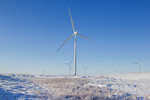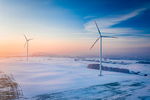News Release from Ørsted (Orsted)
Wind Industry Profile of
Ørsted completes industry-first nearshore artificial nesting structures
Despite a lack of suitable natural nesting sites (i.e. cliffs) in Suffolk, Black-legged Kittiwake (Rissa Tridactyla) have colonised the area and populations are expanding, highlighting its ecological suitability. This makes East Suffolk one of the most likely places for artificial structures to be colonised quickly and for the compensation measures to have the highest chance of success.
The structures are located approximately 1km offshore - with one close to the Minsmere Nature Reserve and the other two located near South Beach, Lowestoft. These nearshore locations place the structures close to existing, thriving kittiwake colonies, whilst minimising disturbance to local residents and business owners.
As the first UK offshore wind project to require ecological compensation, the Hornsea 3 team undertook extensive research to identify optimum locations and design features to maximise the chance that the ANS will be colonised by kittiwake.
A team of architects, engineers and ecologists were commissioned to design the structures in collaboration with local stakeholders and an Offshore Ornithology Engagement Group, which includes Natural England, the Marine Management Organisation (MMO) and the Royal Society for the Protection of Birds (RSPB) as core members.
Each ANS comprises an octagonal topside with capacity for around 500 breeding pairs of kittiwake supported above the water on a single monopile. The roof pitch and overhang were specifically designed to mitigate avian predators.
The nesting faces have alternating rows of fully partitioned, open, and semi-partitioned ledges. This experimental design will provide valuable insight on the nesting preferences of kittiwake and help inform future compensation projects for the industry.
Individual nesting spaces are fitted with a sliding Perspex panel which will allow researchers to view the kittiwake from inside the structures without the birds being able to see them, as well as allowing for safe handling for monitoring purposes.
Two cameras have been installed on each ANS to capture birds prospecting and nesting attempts. Ørsted will also continue to monitor the existing colonies in Lowestoft and Sizewell for the lifetime of the ANS. Additionally, Ørsted is providing an initial £50,000 of funding to the Lowestoft Kittiwake Partnership, which aims to safeguard nesting birds.
Suffolk-based Red7Marine took the Principal Contractor role for the fabrication and installation of the structures, working closely with their contract partner Four Tees Engineering to deliver the unique octagonal nesting structure. All components were delivered to the quayside at Lowestoft for load out onto a jack-up barge before being transported out to location and installed.
Eleni Antoniou, Environmental Manager at Ørsted, said: “Kittiwake are listed as at risk from extinction and with climate change as a key driver to their decline, a move towards a green energy system could help considerably in the long-term conservation of the species. In the meantime, the provision of these structures will provide a safe, nesting space to enable future generations to raise young away from predators and out of town centres.
“This is a first of its kind project that required a great deal of collaborative work with stakeholders, architects, engineers and ecologists to develop a bespoke solution. We have already had our first kittiwake visitor to the structures and look forward to seeing our first long-term residents. We’d like to thank all those involved in this ground-breaking project so far.”
Ørsted would like to thank the team of consultants who have supported the development of these structures: Royal Haskoning DHV, LDA Design, GoBe Consultants, NIRAS, Red7 Marine, Four Tees Engineering, Seiche, Anatec, MSDS Marine and Neubau.
The Ørsted Nearshore Artificial Nesting Structures (ANS) Factfile
- An ANS is an independent marine structure comprising of an octagonal topside with individual nesting spaces supported above the water on a single monopile.
- The topside is 11m wide by 8m tall with a weight of c.50 tonnes.
- The pile is 35m long with a diameter of 1.6m and weighs c.30 tonnes.
- The sleeve over the pile, painted yellow for navigational purposes, is 10.3m long with a weight of c20. tonnes
- Each ANS has capacity for around 500 nesting spaces spread across 8 rows of ledges per nesting face
- Individual nesting spaces are approximately 0.4m in width, 0.4m in height and 0.2m in depth
- Inside the topside there is a space with a table, chairs and whiteboard to allow researchers to record data findings on the birds.
- Each nesting space is fitted with a sliding Perspex panel which will allow researchers to view the kittiwake without the birds being able to see them and minimise disturbance when handling birds for monitoring purposes.
- Two cameras have been installed on each ANS to capture birds prospecting and nesting attempts.
- The structures will be fitted with decoys that will be ready for the 2024 breeding season. These have been specifically made and will be 3D printed with recycled materials.
Why East Suffolk?
Suitable areas for locating an artificial nesting structure for kittiwake were identified based on the following factors:
- Connectivity to existing colonies where productivity has been good over the last five years
- Within range of known prey habitats
- Evidence that natural nesting habitat may be limited
Despite a lack of suitable natural nesting sites (i.e. cliffs) in Suffolk, birds have colonised the area and populations are expanding, highlighting it’s ecological suitability. This makes East Suffolk one of the most likely places for artificial structures to be colonised quickly and for the compensation measures to have the highest chance of success.
Differences between kittiwake and urban nesting gulls
Kittiwake are small, gentle and feed only on marine fish and small crustaceans. They have short black legs with wings that look like they have been “dipped in ink”. Kittiwake spend the winter at sea, returning to nest between March and August each year.
Kittiwake are different to other gull species, such as herring gulls and lesser black-backed gulls, which can be found in towns all year round. These larger “urban” gull species are often protective of their offspring in the summer and may dive and swoop on people who are near their nests or chicks. They are often found eating food from open skips or litter bins and may attempt to take food from people in the outdoors. Kittiwake are not known for doing this and are much gentler in nature.
- Source:
- Ørsted
- Author:
- Press Office
- Link:
- orsted.co.uk/...
- Keywords:
- , nesting structure, nest, nearshore, offshore, wind farm, kittiwake, structure, seabird, impact, Hornsea 3, potential, East Suffolk, compensation


















